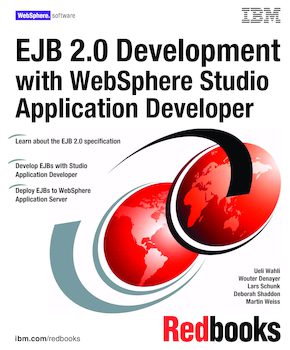EJB 2.0 Development with WebSphere Studio Application Developer
An IBM Redbooks publication
Note: This is publication is now archived. For reference only.

Published on 11 April 2003
ISBN-10: 0738426091
ISBN-13: 9780738426099
IBM Form #: SG24-6819-00
Authors: Ueli Wahli, Wouter Denayer, Lars Schunk, Deborah Shaddon and Martin Weiss
This IBM Redbooks publication provides detailed information on how to effectively use WebSphere Studio Application Developer for the development of applications based on the Enterprise JavaBeans (EJB) architecture, and deployment of such applications to a WebSphere Application Server.
Throughout the book, we provide examples based on a simple banking application with an underlying relational database.
In Part 1, we introduce EJBs as a part of Java 2 Enterprise Edition (J2EE) and cover the basic concepts and the architecture. In particular we point out the new functions introduced with the EJB 2.0 specification that provide, for example, enhanced functionality for container-managed persistence entity beans and message-driven beans. We also provide best practice guidelines for successful implementations of EJBs.
In Part 2, we introduce the sample banking application and then implement entity beans, session beans, and message-driven beans using WebSphere Studio Application Developer. We also implement finder methods, different mapping strategies, and simple clients that use the EJBs. At the end, we describe how to deploy EJB applications to a WebSphere Application Server.
Part 1. EJB architecture and concepts
Chapter 1. Introduction to Enterprise JavaBeans
Chapter 2. EJB architecture and concepts
Chapter 3. Entity beans
Chapter 4. Entity beans advanced: relationships, inheritance, custom queries
Chapter 5. Session beans
Chapter 6. Message-driven beans
Chapter 7. EJB clients
Chapter 8. Additional concepts: transactions, exceptions, security
Part 2. Developing and testing EJBs with Application Developer
Chapter 9. WebSphere Studio Application Developer
Chapter 10. Introducing and preparing for the sample application
Chapter 11. Container-managed entity bean development
Chapter 12. Mapping strategies for CMPs
Chapter 13. Bean-managed entity bean development
Chapter 14. Session bean development
Chapter 15. EJB access beans
Chapter 16. Message-driven bean development
Chapter 17. Client development
Chapter 18. Deployment of enterprise applications
Chapter 19. Application Developer team development environment
Part 3. Appendixes
Appendix A. Setting up the environment
Appendix B. Additional material